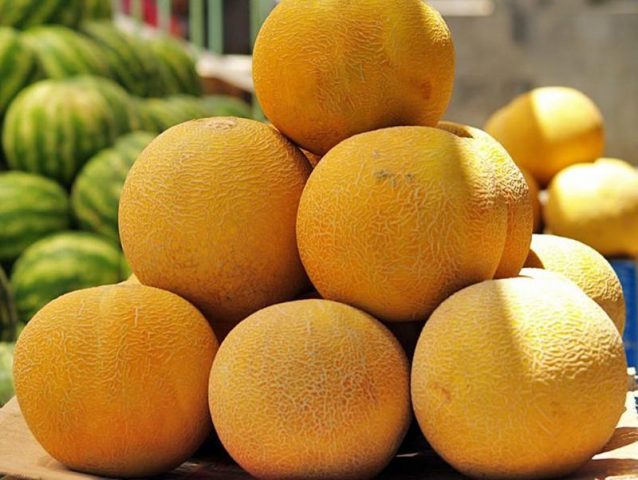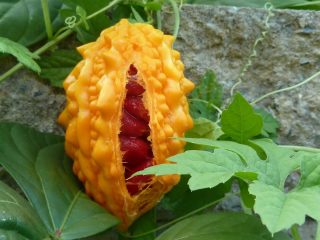Content
- 1 How to choose the right melon
- 2 How to determine the ripeness of a melon
- 3 How to choose the right ripe melon by appearance and color of the fruit
- 4 How to identify a ripe melon by smell
- 5 How to choose ripe and sweet melon by sound
- 6 How to choose a ripe melon by its noses and tails
- 7 How to determine the presence of nitrates in melon by appearance
- 8 In what cases should you refuse a purchase?
- 9 Conclusion
You can choose a sweet melon based on several criteria. Traditional fall fruits such as watermelons and melons are now available year-round. The ripe fruit has moderately dense, juicy pulp and a characteristic sweetish odor. To find the most delicious “torpedo” or “collective farmer”, the buyer only needs to use his hearing, sight and smell. There is no need to cut your future purchase.
How to choose the right melon
You can buy melons and melons in urban areas, especially far from where they grow, in different places:
- in the “vegetables and fruits” departments of supermarkets;
- in specialized vegetable stores;
- at collective farm markets;
- on seasonal breaks.
You should not buy fruit from the trunk of a car or from the ground, even if the seller claims that the product is of excellent quality. Most likely, he does not have documents for the consignment of goods, reliable information about the location of the manufacturer and a personal medical record. When making purchases at a spontaneous decomposition, it is impossible to check the conditions for transporting products.Before sale, melons must be stored in an equipped warehouse, and not in the trunk of a car.
The best time to buy melons is late summer and early autumn, harvest time. During this period, the buyer can choose the most delicious specimen. Modern storage technologies make it possible to preserve the freshness of the melon harvest for a long time, but you can choose the most delicious melon only immediately after it has ripened and been harvested.
Choosing a seller is easy - the best products are from those who professionally sell fresh fruit. These are shops with direct deliveries from plantations, familiar traders at markets or supermarkets with a large selection of seasonal goods. You should not look for the lowest price - the manufacturer and seller, most likely, saved on everything, as a result, the purchase may turn out to be unripe, overripe, or stuffed with chemical fertilizers.
You can distinguish a ripe fruit from an unripe one by the following signs:
- pronounced pleasant sweetish smell;
- dry stalk;
- soft skin;
- dull sound when tapped.
When the melon ripens, the seeds separate from the pulp; after cutting, they can be easily removed with a spoon. Collected unripe, specimens that have not ripened in transit are usually odorless. They have a dense, stubborn crust, and the seeds are tightly connected to the melon pulp. When cutting an unripe fruit, its stalk remains juicy and green.
The advice of the owner of a fruit shop, who recorded a video on how to choose a melon, will help you choose the best specimen.
How to determine the ripeness of a melon
First you need to choose a melon variety. A popular local variety, “kolkhoznitsa,” spoils faster and has a shorter shelf life than the thick-skinned “torpedo.”The ripeness of the “collective farmer” is confirmed by a uniform bright yellow color, without green or white spots, and a sweet aroma. Size is not of fundamental importance for this variety; small round melons are not inferior in taste to large representatives of other varieties. Too large specimens, on the contrary, may begin to deteriorate while still in the melon field or during storage.
When buying a “torpedo”, you should not put aside specimens with green veins on the peel. If the main shade of the fruit is sandy, white and green veins are normal. The aroma of the “torpedo” is more pronounced than that of the “collective farmer”; the sweet smell with notes of pear and vanilla, without sour undertones, indicates that the fruit has reached the required ripeness. The “Torpedo” variety does not lose its taste properties when it reaches a weight of 5 kilograms or more. If all other signs confirm ripeness, you can buy a large “Torpedo”.
How to choose the right ripe melon by appearance and color of the fruit
When inspecting a melon when purchasing, you need to pay attention to the integrity of the peel. You should not buy fruits with cracked skin or rotten sides. Melon pulp contains a large amount of sugar, which is a breeding ground for harmful microorganisms. If there are dents or cuts, germs can get inside the fruit and spoil it. Rotten on one side, the specimen also cannot be divided into infected and clean parts. Therefore, if there are brown spots or an uncharacteristically soft surface, it is better not to buy a melon.
The color of the fruit differs for different varieties, but the general rule for choosing a ripe specimen is uniform color, absence of white or green spots.The use of preservatives during storage or transportation may leave traces of colors uncharacteristic for the variety on the surface, for example, blue stains on the skin of the fruit, a pinkish tint, or pink splashes on a yellow-brown surface.
How to identify a ripe melon by smell
During ripening, the melon changes its smell: from fresh herbaceous to rich sweet, with notes characteristic of the variety. An unripe fruit may have no smell at all; in overripe specimens, the sweetness is replaced by the smell of fermentation or rotting.
Melons grown with the help of chemicals may have all the external signs of ripeness, but will not be quite aromatic. Such specimens may have virtually no smell or have the smell of an unripe fruit, herbal or with a hint of dampness. You can determine ripeness by smell by smelling the melon near the stalk.
How to choose ripe and sweet melon by sound
Tapping the melon helps to understand whether the ripened seeds have separated from the pulp, forming a void, or whether the fruit inside has a solid consistency. The readiness of seeds for reproduction is a characteristic natural sign of the ripening of plant fruits. The pulp becomes juicy and can no longer make a ringing sound when tapped. If the selected specimen sounds dull, this indicates its ripeness.
How to choose a ripe melon by its noses and tails
The “tails” of melons are the stalks that connect the fruits to the trunk of the plant, through which nutrients are supplied. If the crop is harvested at the stage of technical ripeness, the stalk, at the junction with the melon, will be greenish in color and filled with juices. After the fruit ripens, the need for the stalk disappears. It dries and the ripe melon is easily separated.It is at the tail that it is recommended to check the smell.
The side of the ball or ellipse opposite the “tail” is colloquially called the “nose”. It can also be used to confirm the ripeness of a melon. The “nose” should not be too hard or too soft. In the first case, the fruit is probably not ripe, and if the skin in the area of the “spout” is easily dented with a fingernail, the melon pulp has begun to deteriorate.
An ideal specimen has a dried “tail”. Its “nose” is slightly softer than the rest of the fruit. Combined with the uniformity of color and smell, it is possible to identify a melon that has been ripened in the melon field and has not been subjected to additional manipulation to appear riper on the road or in the warehouse.
How to determine the presence of nitrates in melon by appearance
The use of fertilizers containing nitric acid salts or nitrates when growing melon cannot be determined by external signs. In the absence of a special measuring device that allows one to determine on the spot the excess of these components harmful to health in vegetables and fruits, one can suspect that chemical additives are being abused at the place of origin of the melon only by indirect signs, for example, the absence of a pronounced aroma during external ripeness or spots of an uncharacteristic color .
In what cases should you refuse a purchase?
You should not purchase vegetables and fruits that will not be cooked before consumption on roadsides or unequipped street stands. When kept near a busy highway for a long time, the fruits, like a sponge, absorb harmful substances. Unorganized trade is often carried out without the necessary documents; the origin of melons is known only from the words of the seller.
When purchasing in a store or not at a market, if the sanitary condition of the outlet is in doubt and the seller does not have the necessary documents for the goods, it is reasonable to look for another place to purchase melon.
Doubts regarding appearance, shape or smell should be resolved in favor of refusing the purchase. Common defects indicating that the melon is of poor quality:
- unpleasant odor (putrid, rotten or too strong) emanating from the fruit;
- dark spots on the surface indicating that the fruit is rotten;
- black spots on the peel, indicating bacterial infection;
- mechanical dents or cracks in the skin.
If the seller has a cut melon of the same variety and external ripeness, it is better not to choose a purchase from the same batch, in the absence of a sweet, rich smell. It is better not to buy the cut melon itself unless you are sure in what sanitary conditions the cutting was carried out. Also, you should not ask the seller at the stall to cut the unwashed fruit with his knife. Desserts in the form of pieces of ripe melon can be bought in cafes or supermarkets, where sanitary standards are ensured and expiration dates are monitored.
Conclusion
The easiest time to choose a sweet melon is during the ripening season of this crop, in late summer - early autumn. The best specimens have a rich aroma and juicy sweet flesh. A melon ripened in the garden has a dry tail, and the seeds have separated from the pulp, which is why the fruit makes a dull sound when tapped. It is better to make purchases from trusted sellers, specialized retail outlets or retail chains. It is impossible to determine the excess of nitrates by appearance.













